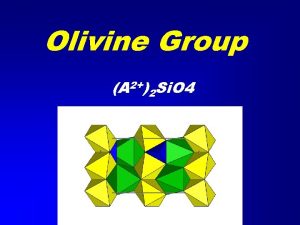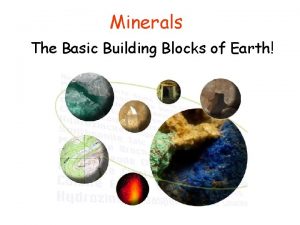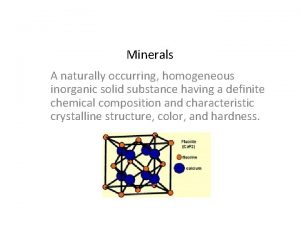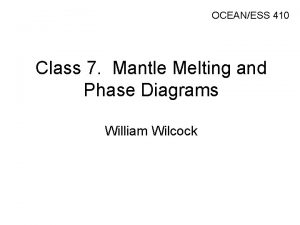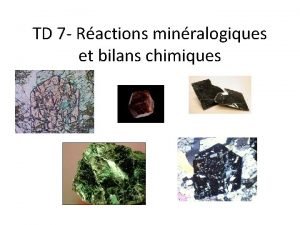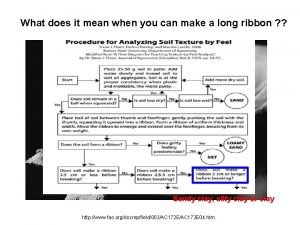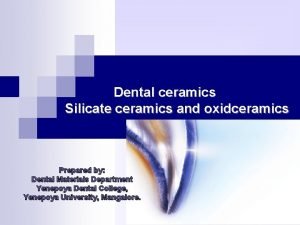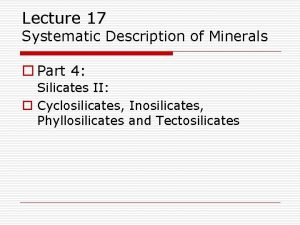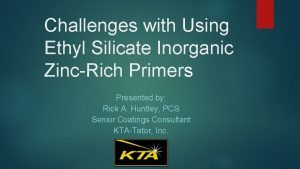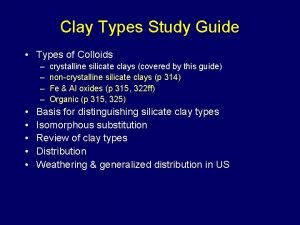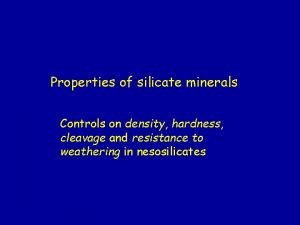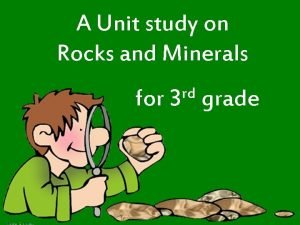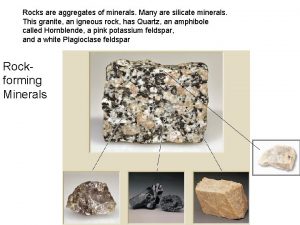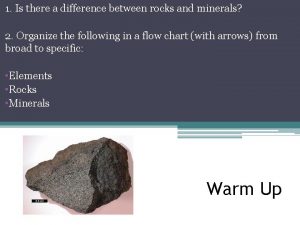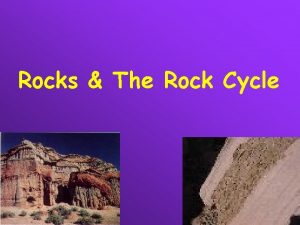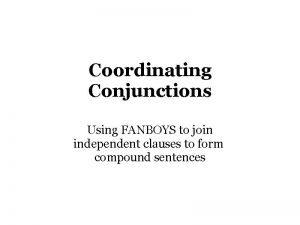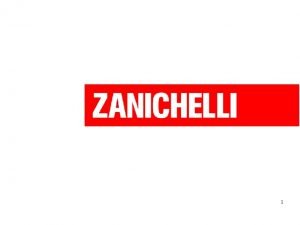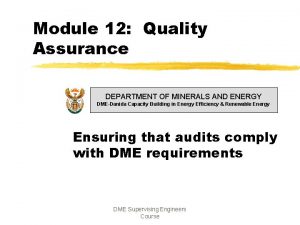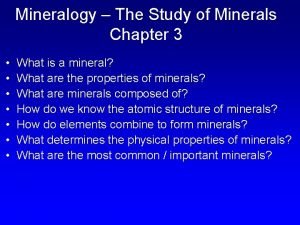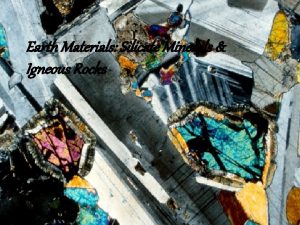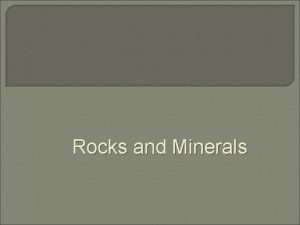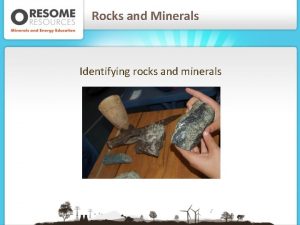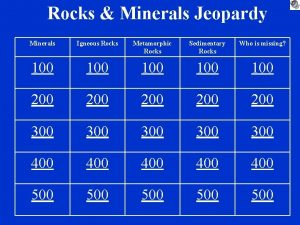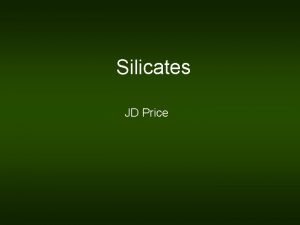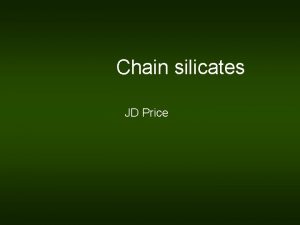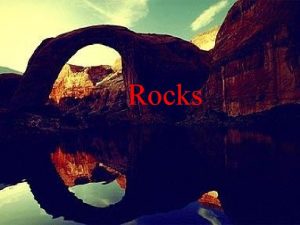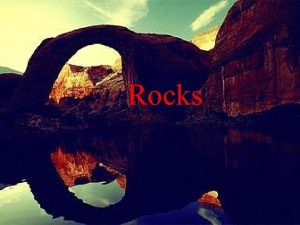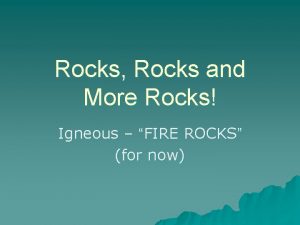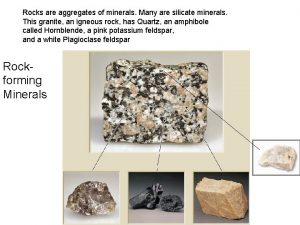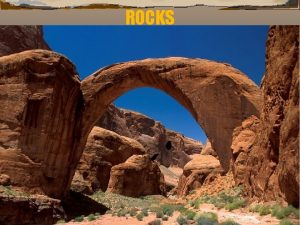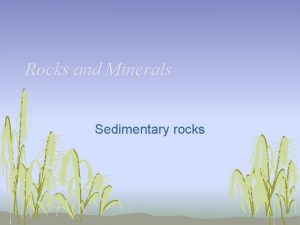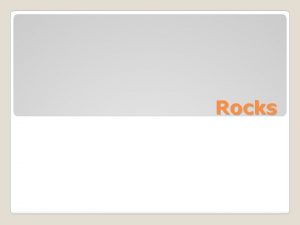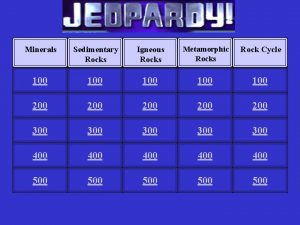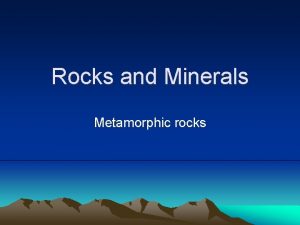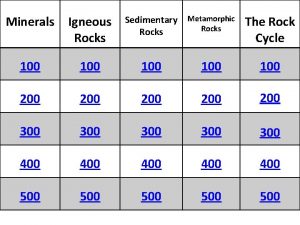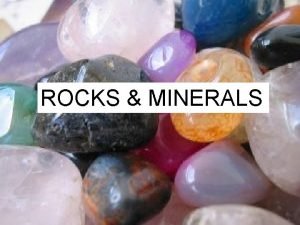Minerals vs Rocks Common silicate minerals Olivine independent




































- Slides: 36

Minerals vs. Rocks Common silicate minerals: Olivine- independent tetrahedra joined by Fe or Mg Pyroxene- single chains of linked tetrahedra Amphibole- double chains of linked tetrahedra Micas and Clays- 2 -D sheets of linked tetrahedra Quartz- 3 -D framework of fully polymerized tetrahedra Feldspar- also a 3 -D framework, but Al, Na, Ca, or K can substitute

Minerals vs. Rocks Common non-silicate minerals: Calcite- Ca. CO 3 a carbonate Dolomite- Ca. Mg(CO 3)2 Apatite- Calcium phosphate (PO 4) Halite- Na. Cl Gypsum- hydrated Ca. SO 4

Rock Types l Igneous

Rock Types l Igneous Polished slab of granite 10 cm across Thin section of basalt 4 mm across

Rock Types l Sedimentary l Metamorphic

2) The Earth’s Interior

General Geological Principles: 1) Geologic Time


Geologic Time l Relative dating by superposition, cross-cutting relationships, fossils and evolution

Geologic Time l Relative dating by superposition, cross-cutting relationships, fossils and evolution Absolute dating by radioactive decay (igneous) 1 # parent atoms l ½ ¼ time

Isostasy Wood density 0. 5 8 g 2 g 3 g 5 g 5 g 3 g 2 g Water density 1. 0 Each block weighs 2 g 0. 5 0. 3 0. 2 density = 0. 1 0. 2 Water density 1. 0 0. 3 0. 5

Isostasy

Isostasy

3) Plate Tectonics

Divergent and Transform Plate Boundaries

Continental Rifting

Continental Rifting the East African Rift

Convergent Plate Boundaries

“Andean-type” orogenesis Crust thickens by addition of magma l Compression due to plate convergence l

Convergent Plate Boundaries The Origin of the Himalayas

“Himalayan-type” orogenesis Begins as Andean-type

“Himalayan-type” orogenesis How do you locate the “suture zone” today? How can you determine the “polarity” of subduction?

Slivers of oceanic crust and upper mantle (ophiolites) The “suture zone” is marked by the mélange and become incorporated into the “mélange” in the particularly by the occurrence of ultramafic rocks accretionary wedge of deformed sediments composing the mantle portion of the ocean lithosphere

Chain of ultramafic bodies in Vermont indicating a suture zone of the Ordovician Taconic Orogeny. The ultramafics mark a closed oceanic basin between North American rocks and an accreted island arc terrane. From Chidester, (1968) in Zen et al. , Studies in Appalachian Geology, Northern and Maritime. Wiley Interscience.

Appalachian History Can “accrete” island arc terranes as well as continents

Accreted Terranes of the Western Cordillera

Hot Spots

The Plate Tectonic Regime of the Western USA

Earthquakes and Plate Tectonics

General Geological Principles: 4) The Rock Cycle

Plate Tectonics and the Rock Cycle

Examples of Other Cycles: the Hydrologic Cycle

Examples of Other Cycles: the Carbon Cycle

Population

Population

Population Impacts: Resources Waste Disposal Pollution Hazards/Disasters Farmland Food/Soil Disruption of Natural Systems l l l
 Olivine group of minerals
Olivine group of minerals Luster
Luster The basic building block of the silicate minerals
The basic building block of the silicate minerals Hardness scale
Hardness scale Rock cycle song (sedimentary igneous metamorphic)
Rock cycle song (sedimentary igneous metamorphic) Igneous metamorphic and sedimentary
Igneous metamorphic and sedimentary Homogeneous minerals
Homogeneous minerals Olivine melting point
Olivine melting point Formule chimique du plagioclase
Formule chimique du plagioclase Is muscovite a silicate
Is muscovite a silicate Silicate ceramics definition
Silicate ceramics definition Opx
Opx Zinc ethyl silicate primer
Zinc ethyl silicate primer Crystalline silicate clays
Crystalline silicate clays Silicate hardness
Silicate hardness Difference between minerals and rocks
Difference between minerals and rocks Rocks and minerals
Rocks and minerals Rocks are aggregates of minerals
Rocks are aggregates of minerals Map of igneous rock
Map of igneous rock What type of rock is this
What type of rock is this Suzanna socked me sunday poem
Suzanna socked me sunday poem Why is bowen's reaction series important
Why is bowen's reaction series important Difference between rocks and stones
Difference between rocks and stones Solid rock cycles
Solid rock cycles Extrusive rocks
Extrusive rocks Site:slidetodoc.com
Site:slidetodoc.com Independent clause fanboys independent clause
Independent clause fanboys independent clause Common metamorphic rocks
Common metamorphic rocks Highest common factors and lowest common multiples
Highest common factors and lowest common multiples Factor tree of 48
Factor tree of 48 Lowest common factor
Lowest common factor Greatest common factor of 20 and 36
Greatest common factor of 20 and 36 What is the least common multiple of 18 and 27
What is the least common multiple of 18 and 27 Common anode and common cathode
Common anode and common cathode Absorbs water and minerals
Absorbs water and minerals Minerals in water
Minerals in water Study of minerals
Study of minerals
